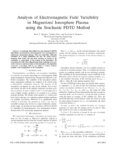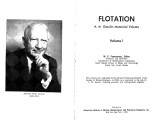Filters: Format: "application/pdf" School Or College: "College of Engineering" Collection: "ir_uspace"
| Creator | Title | Description | Subject | Date | ||
|---|---|---|---|---|---|---|
| 226 |
 | Harrison, Reid R.; Myers, Chris J.; Schlegel, Christian | Analog decoding of product codes | A method is presented for analog softdecision decoding of block product codes (block turbo codes). Extrinsic information is exchanged as analog signals between component row and column decoders. The component MAP decoders use low-power analog computation in subthreshold CMOS circuits to implement th... | 2002 | |
| 227 |
 | Myers, Chris J. | Analog decoding of product codes | A design approach is presented for soft-decision decoding of block product codes ("block turbo codes") using analog computation with MOS devices. Application of analog decoding to large code sizes is also considered with the introduction of serial analog interfaces and pipeline schedules. | 2001 | |
| 228 |
 | Myers, Chris J.; Harrison, Reid R.; Schlegel, Christian | Analog decoding of product codes | Abstract - A method is presented for analog softdecision decoding of block product codes (block turbo codes). Extrinsic information is exchanged as analog signals between component row and column decoders. The component MAP decoders use low-power analog computation in subthreshold CMOS circuits t... | 2002 | |
| 229 |
 | Harrison, Reid R.; Myers, Chris J.; Schlegel, Christian | Analog decoding of product codes | A design approach is presented for soft-decision decoding of block product codes ("block turbo codes") using analog computation with MOS devices. Application of analog decoding to large code sizes is also considered with the introduction of serial analog interfaces and pipeline schedules. | 2001-01-11 | |
| 230 |
 | Myers, Chris J.; Schlegel, Christian | Analog MAP decoder for (8, 4) hamming code in subthreshold CMOS | Abstract - An all-MOS analog tail-biting MAP decoder is presented for an (8,4) Hamming code. The decoder implements a probability propagation algorithm using subthreshold CMOS networks. Physical results verify the expected behavior of the decoderand demonstrate robustness of analog decoding circuit... | 2001 | |
| 231 |
 | Myers, Chris J.; Schlegel, Christian | Analog MAP decoder for (8, 4) hamming code in subthreshold CMOS | An all-MOS analog implementation of a MAP decoder is presented for the (8, 4) extended Hamming code. This paper describes the design and analysis of a tail-biting trellis decoder implementation using subthreshold CMOS devices. A VLSI test chip has recently returned from fabrication, and preliminary ... | 2001 | |
| 232 |
 | Harrison, Reid R. | Analog MAP decoder for (8,4) hamming code in subthreshold CMOS | An all-MOS analog tail-biting MAP decoder is presented for an (8,4) Hamming code. The decoder implements a probability propagation algorithm using subthreshold CMOS networks. Physical results verify the expected behavior of the decoder and demonstrate robustness of analog decoding circuits. | MAP decoder; Hamming code; VLSI | 2004-01-01 |
| 233 |
 | Harrison, Reid R. | Analog VLSI implementation of a visual interneuron: enhanced sensory processing through biophysical modeling | Flies are capable of rapid, coordinated flight through unstructured environments. This flight is guided by visual motion information that is extracted from photoreceptors in a robust manner. One feature of the fly's visual processing that adds to this robustness is the saturation of wide-fi_x000... | 1999-01-01 | |
| 234 |
 | Harrison, Reid R. | Analog VLSI model of the fly elementary motion detector | Flies are capable of rapidly detecting and integrating visual motion information in behaviorly-relevant ways. The first stage of visual motion processing in flies is a retinotopic array of functional units known as elementary motion detectors (EMDs). Several decades ago, Reichardt and colleagues de... | 1998-01-01 | |
| 235 |
 | Riloff, Ellen M. | Analyses for elucidating current question answering technology | In this paper, we take a detailed look at the performance of components of an idealized question answering system on two diff erent tasks: the TREC Question Answering task and a set of reading comprehension exams. We carry out three types of analysis: inherent properties of the data, feature analys... | TREC Question Answering task | 2001-12 |
| 236 |
 | Carter, John B. | Analysis of avalanche's shared memory architecture | In this paper, we describe the design of the Avalanche multiprocessor's shared memory subsystem, evaluate its performance, and discuss problems associated with using commodity workstations and network interconnects as the building blocks of a scalable shared memory multiprocessor. Compared to other ... | Avalanche multiprocessor; Shared memory | 1997 |
| 237 |
 | Furse, Cynthia M. | Analysis of electromagnetic field variability in magnetized ionosphere plasma using the stochastic FDTD method | A stochastic finite-difference time-domain (S-FDTD) algorithm is presented for electromagnetic wave propagation in anisotropic magnetized plasma. This new algorithm efficiently calculates in a single simulation not only the mean electromagnetic field values, but also their variance as caused by the ... | 2014-01-01 | |
| 238 |
 | Furse, Cynthia M. | Analysis of spread spectrum time domain reflectometry for wire fault location | Spread spectrum time domain reflectometry (SSTDR) and sequence time domain reflectometry have been demonstrated to be effective technologies for locating intermittent faults on aircraft wires carrying typical signals in flight. This paper examines the parameters that control the accuracy, latency, ... | Spread spectrum; Sequence time domain reflectometry; STDR; SSTDR; Wire fault location; Aging wire detection; Arc detection | 2005-12 |
| 239 |
 | Mathews, V. John | Analysis of the short-time unbiased spectrum estimation algorithm | Abstract- The short-time unbiased spectrum estimation (STUSE) algorithm is analyzed and expressions for the mean and variance of the spectrum estimates are derived. The STUSE algorithm deliberately adds biased spectrum estimates in order to yield unbiased estimates and at the same time have excellen... | 1985 | |
| 240 |
 | Miller, Jan D. | Analysis of the surface potential developed by non-reactive ionic solids | The sign of the surface potential for complex non-reactive ionic solids cannot be predicted solely from consideration of the hydration energy of gaseous ions which constitute the ionic lattice. Accurate analysis of these systems must involve the hydration energy of surface ions, which requires knowl... | Lattice; dipole; madelung constants | 1976 |
| 241 |
 | Sobh, Tarek M. | Analysis of tolerance for manufacturing geometric objects from sense data | In this work we address the problem of manufacturing machine parts from sense data. Constructing geometric models for the objects from sense data is the intermediate step in a reverse engineering manufacturing system. Sensors are usually inaccurate, providing uncertain sense information. We constr... | Manufacture | 1993 |
| 242 |
 | Henderson, Thomas C. | Analysis of topographic maps for recreational purposes using decision trees | In this paper we describe a method for predicting the subjective quality of a new mountain bike route for a particular subject based on routes previously ridden and ranked by the subject. GPS tracks of the previously ridden routes are over laid on rasterized topographic maps and topographic features... | 2013-01-01 | |
| 243 |
 | Weinstein, David | The analytic 3-D transform for the least-squared fit of three pairs of corresponding points | We derive the analytic transformation for minimizing the summed-squared-distance between three movable points in one three-space pose to three corresponding fixed points in another three-space pose. This change of basis is a general rigid-body transformation (translation and rotation), with the addi... | 3-D transform; summed-squared-distance; three movable points; Three-space | 1998 |
| 244 |
 | Yang, Yue; Gopalakrishnan, Ganesh; Lindstrom, Gary E.; Slind, Konrad Lee | Analyzing the Intel Itanium memory ordering rules using logic programming and SAT | We present a non-operational approach to specifying and analyzing shared memory consistency models. The method uses higher order logic to capture a complete set of ordering constraints on execution traces, in an axiomatic style. A direct translation of the semantics to a constraint logic program... | Intel Itanium memory; Ordering rules; Sared memory; Consistency models | 2003 |
| 245 |
 | Bargteil, Adam Wade | Animation of deformable bodies with quadratic bézier finite elements | In this article, we investigate the use of quadratic finite elements for graphical animation of deformable bodies.We consider both integrating quadratic elements with conventional linear elements to achieve a computationally efficient adaptive-degree simulation framework as well as wholly quadratic ... | 2014-01-01 | |
| 246 |
 | Miller, Jan D. | Anisotropic character of talc surfaces as revealed by streaming potential measurements, atomic force microscopy, and molecular dynamics simulations | A study of the interfacial properties of the basal plane and the edge surfaces of talc is described in this paper. The isoelectric-point measured at the two different crystallographic planes by the streaming potential method was found to be similar and exists at about pH 3.0. In the case of the edg... | Streaming potential; Scanning electron microscope; Atomic force microscope | 2006 |
| 247 |
 | Miller, Jan D. | Anisotropic character of talc surfaces as revealed by streaming potential measurements, atomic force microscopy, molecular dynamics simulations and contact angle measurements | A study of the interfacial properties of the basal plane and the edge surfaces of talc is described in this paper. The isoelectric points measured at two different crystallographic surfaces by the streaming potential method were found to be similar and exist at about pH 3.0. In the case of the edge... | Talc; Interfacial properties; Hydration; Atomic force microscopy; Molecular dynamics simulations; Edge surface; Basal plane | 2007 |
| 248 |
 | Tasdizen, Tolga; Whitaker, Ross T. | Anisotropic diffusion of surface normals for feature preserving surface reconstruction | For 3D surface reconstruction problems with noisy and incomplete range data measured from complex scenes with arbitrary topologies, a low-level representation, such as level set surfaces, is used. Such surface reconstruction is typically accomplished by minimizing a weighted sum of data-model dis... | Anisotropic diffusion; Surface reconstruction | 2003-04-18 |
| 249 |
 | Tasdizen, Tolga; Whitaker, Ross T. | Anisotropic diffusion of surface normals for feature preserving surface reconstruction | For 3D surface reconstruction problems with noisy and incomplete range data measure d from complex scenes with arbitrary topologies, a low-level representation, such as level set surfaces, is used. Such surface reconstruction is typically accomplished by minimizing a weighted sum of data-model discr... | 2003 | |
| 250 |
 | Tasdizen, Tolga; Whitaker, Ross T. | Anisotropic diffusion of surface normals for feature preserving surface reconstruction | For 3D surface reconstruction problems with noisy and incomplete range data measured from complex scenes with arbitrary topologies, a low-level representation, such as level set surfaces, is used. Such surface reconstruction is typically accomplished by minimizing a weighted sum of data-model discre... | 2003 |
